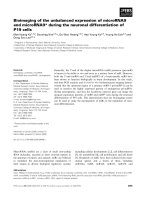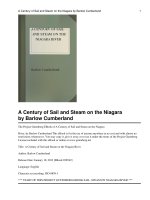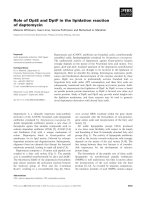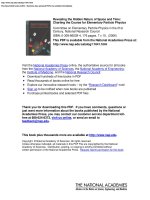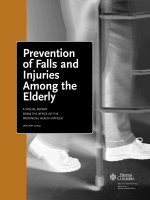Maillard reaction products of chitosan and glucosamine: Antibacterial and antioxidant activity
Bạn đang xem bản rút gọn của tài liệu. Xem và tải ngay bản đầy đủ của tài liệu tại đây (269.52 KB, 4 trang )
Nuclear Science and Technology, Vol.10, No. 1 (2020), pp. 47-55
Maillard reaction products of chitosan and glucosamine:
antibacterial and antioxidant activity
Le Anh Quoc1, 2, Dang Van Phu1, Nguyen Ngoc Duy1, Nguyen Quoc Hien1, Ngo Dai Nghiep2
1
Research and Development Center for Radiation Technology, Vietnam Atomic Energy Institute
202A, Str. 11, Linh Xuan Ward, Thu duc District, Ho Chi Minh City
2
University of Science, Vietnam National University, Ho Chi Minh City Vietnam
227 Nguyen Van Cu Str., District 5, Ho Chi Minh City
Email:
(Received 04 November 2019, accepted 05 January 2020)
Abstract: Maillard reactions between chitosan and glucosamine were induced by Co-60 gamma
irradiation method and the antibacterial and antioxidant activities of resulting products were
investigated. Briefly, a mixture of chitosan (1%) - glucosamine (0.5%) was irradiated with a dose
range of 0-100 kGy. The Maillard reaction products of chitosan and glucosamine (CTS-GA MRPs)
were analyzed by UV spectrophotometry, and residual glucosamine was determined by high
performance liquid chromatography (HPLC). Antibacterial and antioxidant activities of the CTS-GA
MRPs were investigated with radiation dose and pH by using directly contacted and ATBS •+ free
radical scavenging methods. The results indicated that the CTS-GA MRPs formed at 25 kGy exhibited
high antibacterial activity at both pH 5 and 7. On the other hand, antioxidant activity of CTS-GA
MRPs increased with the increase of dose. The results also revealed that CTS-GA MRPs with high
antimicrobial and antioxidant activities are potential candidates as preservative agents in food
processing and cosmetics.
Keywords: Chitosan, glucosamine, Maillard reaction, gamma Co-60, antibacterial, antioxidant.
I. INTRODUCTION
In recent years, because of more and
more consumer's awareness and concern
regarding the safe of synthetic additives,
number of publications on additives of
natural origin has increased dramatically.
Many natural compounds have been studied
and used as safe additives because of their
non-toxicity. These natural biomaterials are
very diverse, including essential oils from
plants, enzymes from animals, bacteriocins
from microorganisms, organic acids and
natural polymers from various sources [1].
Among of these compounds, chitosan has
received
considerable
interest
for
commercial
applications
in
medical,
agricultural, chemical and food industry.
Chitosan, which is composed of Dglucosamine and N-acetyl-D-glucosamine, is
a deacetylated derivative of the second most
abundant biopolymer – chitin [2]. Chitosan is
a well-known polysaccharide with nontoxic,
biocompatible and biodegradable properties
[3]. Therefore, chitosan and its derivatives
have been intensively studied and applied in
various field due to their antibacterial and
antioxidative activities [4, 5]. In fact,
chitosan has been approved as food additive
in Japan and Korean since 1983 and 1995,
respectively [6, 7]; and in 2001, shrimpderived chitosan has archived a GRAS
(Generally Recognized as Safe) for use in
foods, including meat and poultry by US
Food and Drug Administration [8].
©2020 Vietnam Atomic Energy Society and Vietnam Atomic Energy Institute
MAILLARD REACTION PRODUCTS OF CHITOSAN AND GLUCOSAMINE …
The applications of chitosan as a
preservative for many kinds of food have been
widely reported in many studies, such as for
fruit and vegetable [9, 10], seafood [11]; meat
and meat products [2, 4, 8, 12, 13].
Unfortunately, the applications of chitosan are
limited by its solubility, namely chitosan can
only dissolve in acidic media while in
neutral/alkaline media, chitosan is precipitated
and reduced the biological activities as a result.
Therefore, several studies have been carried
out to improve the solubility and/or the
biological activities of chitosan upon chemical
and enzymatic modifications, in which
chemical modification are generally not
preferred in food applications [14].
been few reports on preparation of chitosanglucosamine MRPs by gamma irradiation.
The present study was carried out to
investigate the formation of MPRs of chitosan
and glucosamine by irradiation treatment.
Radiation effect on efficiency of condensation
reaction as well as antioxidant and
antibacterial activities of resulting MPRs were
also studied.
II. CONTENT
A. Material and methods
Materials: Chitosan from shrimp shell
with the average molecular weight (Mw) of
123.5 kDa and degree of deacetylation of
93.3 % was supplied by a factory in Vung
Tau province, Vietnam. Glucosamine was
purchased by Merk (Germany). The E. coli
ATCC 6538 was provided by Metabolic
Biology Laboratory, University of Science,
Ho Chi Minh City. The Luria- Bertani
medium and agar plates used for bacteria
incubation were purchased from Himedia,
India. Ultra pure ABTS diammonium salt
and potassium ferricyanide were products
from Sigma-Aldrich. Other chemicals are in
analytical grade. Distilled water is used for
all experiments.
The Maillard reaction, a non-enzymatic
browning reaction, is a complex condensation
reaction between carbonyl groups of reducing
sugars, aldehydes or ketones, and amino
groups of amino acids, proteins or any
nitrogenous compounds [13]. Many studies
have reported that a myriad of products are
formed by Maillard reaction, generally termed
Maillard reaction products (MRPs), exhibit
strong antioxidant and antibacterial activities
[15]. In addition, a MRP obtained by heatinduced Maillard reaction has been reported
to have a relatively high antibacterial activity
against Escherichia coli and Staphylococcus
aureus as compared with the native chitosan
[16]. Therefore, formation of MRPs is a
desirable strategy to modify chitosan with
improved bioactivities. It also found that
MRPs can be rapidly formed during gamma
irradiation of chitosan-glucose admixture.
This radiation condensation of MRPs does not
produce any harmful by-product (5hydroxymethylfurfural) like heat-induced
Maillard reaction, as well as any other
reagents [16]. However, up to now, there has
Preparation of chitosan-glucosamine MRPs
The preparation of chitosan-glucosamine
MRPs solutions were carried out according to
the method of Rao et al. (2011) with some
modification [16]. A 2% solution of chitosan in
acetic acid (1%) was prepared. Similarly,
various solutions of glucosamine in distilled
water were prepared with different contents of
1, 2 and 4 % respectively. The chitosan
solutions were mixed to these glucosamine
solutions with the ration 1:1 (v:v) separately in
order to obtain three mixture solutions, namely
48
LE ANH QUOC et al.
A solution: chitosan 1% - glucosamine 0.5%; B
solution: chitosan 1% - glucosamine 1% and C
solution chitosan 1% - glucosamine 2%. All
solutions were exposured to γ-irradiation with
doses in the range of 0–100 kGy by a Gammacell 5000 (BRIT, Mumbai, India) at the same
dose rate of 2.2 kGy/h.
radical solution was prepared by mixing 7.4
mM ABTS and 2.6 mM K2S2O8 in aqueous
solution with the same volume and kept in the
dark for 16h at room temperature, and then
diluted by water to reach the optical density of
1 ± 0.1 as measured with UV-vis
spectrophotometer at the wavelength of 734
nm (OD734). 0.6 ml of each solution was
thoroughly mixed with 1 ml ATBS•+ radical
solution to obtain the desired concentrations.
On another hand, 1 ml ABTS solution (without
K2S2O8) diluted with water was also added 0.6
ml of each solution with the same
concentration for preparation of the blank
samples. The OD734 measuring was carried out
triplicate for each sample and the percentage of
ATBS•+ radical scavenging was calculated as
following equation:
Spectrophotometric analyses
The
irradiated
solutions
were
characterized by spectrophotometric analyses
described by Chawla et al. (2009) [18]. The asprepared solutions were appropriately diluted
and the absorbance was measured at 284 nm
(early Maillard reaction products) and 420 nm
(late Maillard reaction products) for
determining UV absorbance and browning
intensity, respectively by a
UV–vis
spectrophotometer, Jasco-V630, Japan.
ATBSã+ radical scavenging (%) = (AC AS) ì
100/AC
(2)
Determination of glucosamine content
Where AC is the OD734 of the control
(ATBS•+ radical solution and water) and the AS
is the OD734 of ATBS•+ radical solution and
tested solutions.
The glucosamine content of irradiated
solutions
were
determined
by
high
performance liquid chromatography (HPLC)
according to AOAC 2012 (2005.01) at Binh
Duong Quality Control Centre, Vietnam. The
efficiency of Maillard reaction was calculated
as the ratio of reacted glucosamine to total
added glucosamine as following:
Evaluation of antibacterial activity
The antibacterial activities of chitosanglucosamine (CTS-GA) MRPs prepared by
gamma irradiation at different doses were
investigated against Escherichia coli 6538 in
both qualitative and quantitative tests.
Maillard reaction efficiency (%) = (M0 – Mt) ×
100/M0
(1)
Where M0 and Mt are glucosamine
contents in the CTS-GA solution before and
after irradiation, respectively.
In qualitative test, the agar well
diffusion method was applied as described
by Balouiri et al. [21]. The LB agar plates
after being spread by E. coli (~ 104 CFU/ml)
on the surface were punched aseptically with
a sterile tip to form wells with a diameter of
6 mm. 100 μl of CTS-GA MRPs prepared
with different irradiation doses of 0-100 kGy
were introduced to the wells respectively.
Then the plates were incubated overnight at
Determination of antioxidant activity
Antioxidant activities of glucosamine,
CTS and irradiated CTS-GA solutions were
determined by ATBS•+ radical scavenging test
described by Zhai et al. [19] and Chen et al.
[20] with some modification. Briefly, ATBS•+
49
MAILLARD REACTION PRODUCTS OF CHITOSAN AND GLUCOSAMINE …
37ºC and monitored colony formation. The
glucosamine solution was also tested by this
method as the control.
in which the pH was already adjusted to 5
and 7 by lactic acid 0.5 % and/or NH4OH 5%
solution. Then the mixtures were shaken at
150 rpm for 4 hours and subsequently
determined the survival cell density by
spread plate technique. The control sample
only containing bacteria suspension and
water was carried out parallel. The
antimicrobial activity of the CTS-GA MRPs
was expressed by the reduction of bacteria
density (log CFU/ml) in the testing mixture
in comparison with the control.
The biological activities of chitosan,
such as antibacterial activity, are highly
dependent on its solubility. Native chitosan
only dissolves in acidic media and
precipitates in neutral/alkaline media.
Therefore
in
quantitative
test,
the
antibacterial activity of CTS-GA MRPs
against E. coli was investigated in both
acidic and alkaline medium, namely at pH 5
and pH 7 respectively. Briefly, 1 ml CTS-GA
MRPs solutions were simultaneously added
into 19 ml E. coli suspensions (107 CFU/ml),
B. Results and discussion
Formation of CTS-GA MRPs
Fig. 1. UV absorbance (284 nm) and browning (420 nm) of irradiated CTS-GA solutions at various
irradiation doses (A: CTS 1% - GA 0.5%; B: CTS 1% - GA 1% and C: CTS 1% - GA 2 %).
There was a change in visual color of
the CTS-GA solutions from colorless to dark
brown during irradiation process. Moreover,
the increases in UV absorbance and
browning intensity of CTS-GA solutions
with irradiation dose were also observed as
in Fig. 1. The same results were recorded in
other studies where the CTS/sugar solutions
were treated by heating [17] or irradiating
[16]. In addition, although the CTS:GA ratio
was different, the various solutions had a
similar change in UV absorbance and
browning intensity, namely 284 nm
absorbance increased dramatically in dose
range of 0-25 and then nearly steady up to
the dose of 100 kGy while the 420 nm
absorbance increased regularly with the
increasing irradiation dose. In Maillard
reaction, the UV absorbance intermediate
compounds were developed prior to the
generation of brown pigments. Therefore the
results of spectrophotometric analyses
indicate that during the irradiation process,
the MRPs were formed, in which the
formation of early MRPs were almost
saturated at the dose of 25 kGy, while the
late MRPs were produced continuously along
with the dose up to 100 kGy.
50

